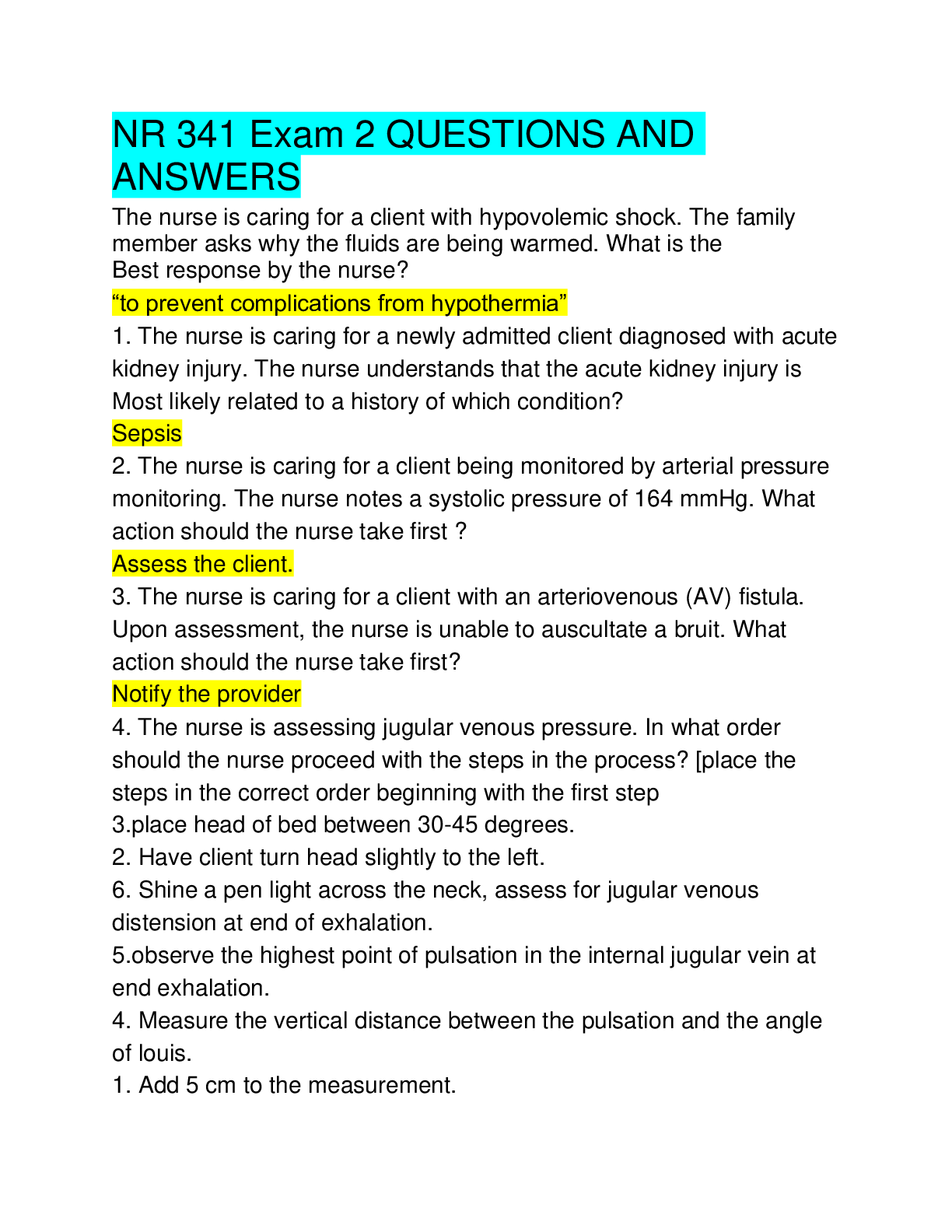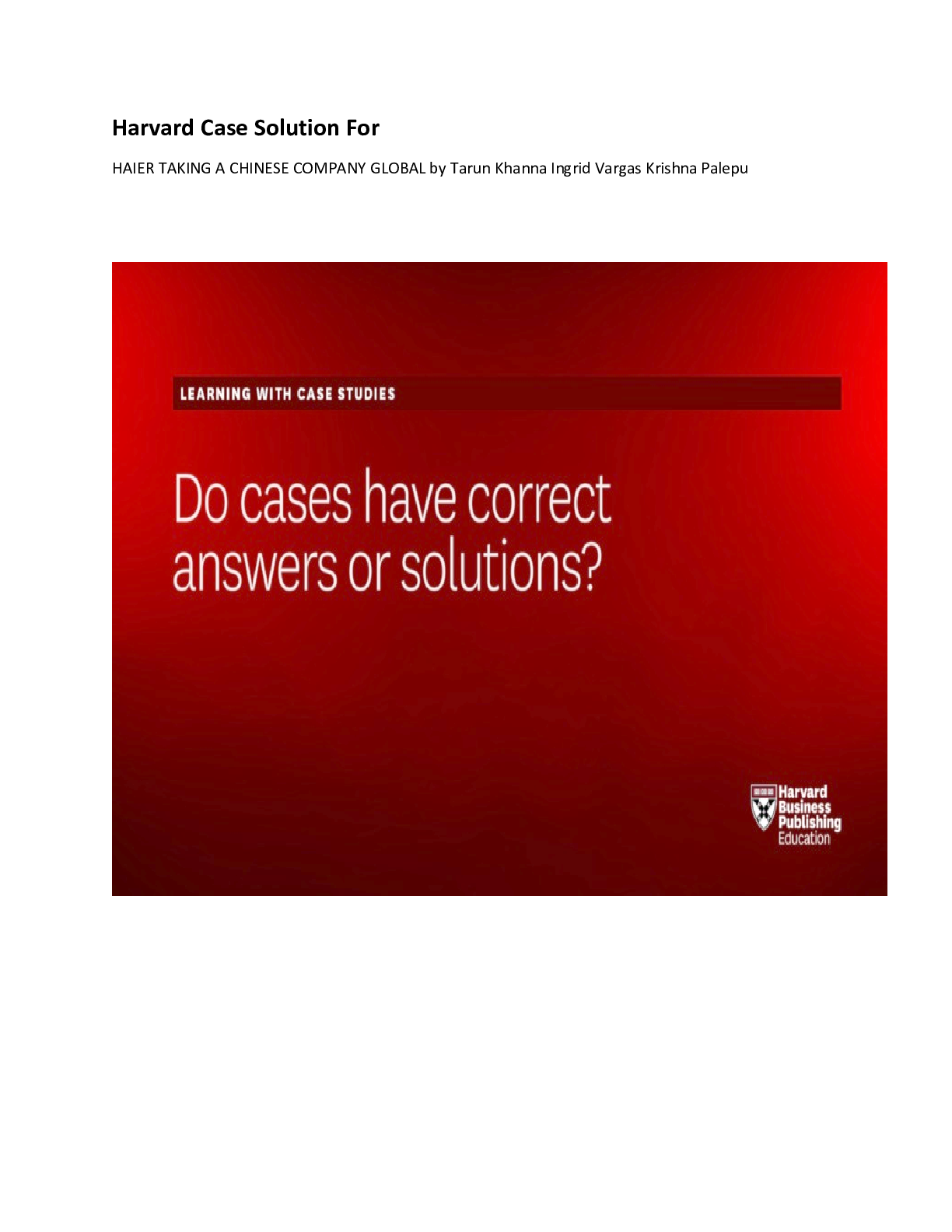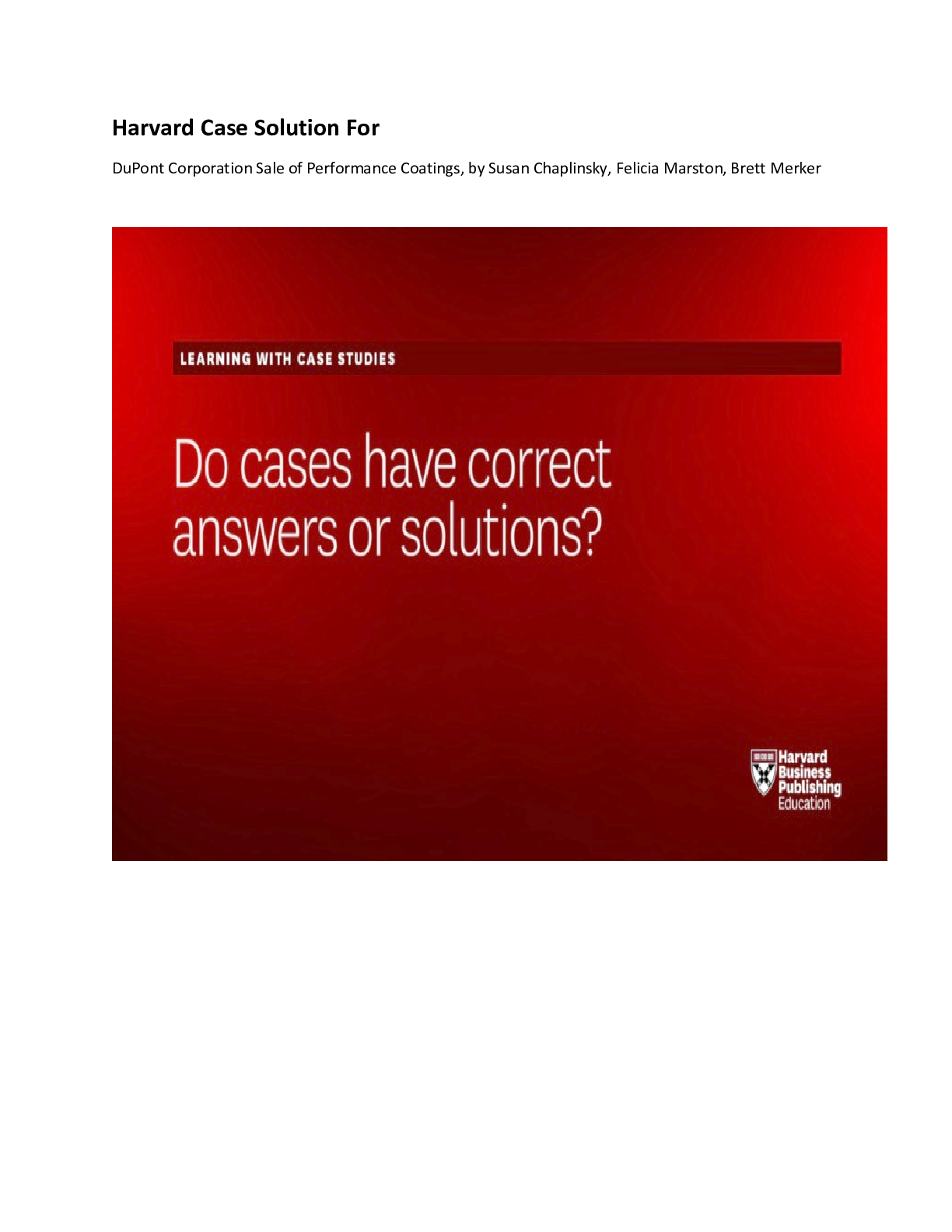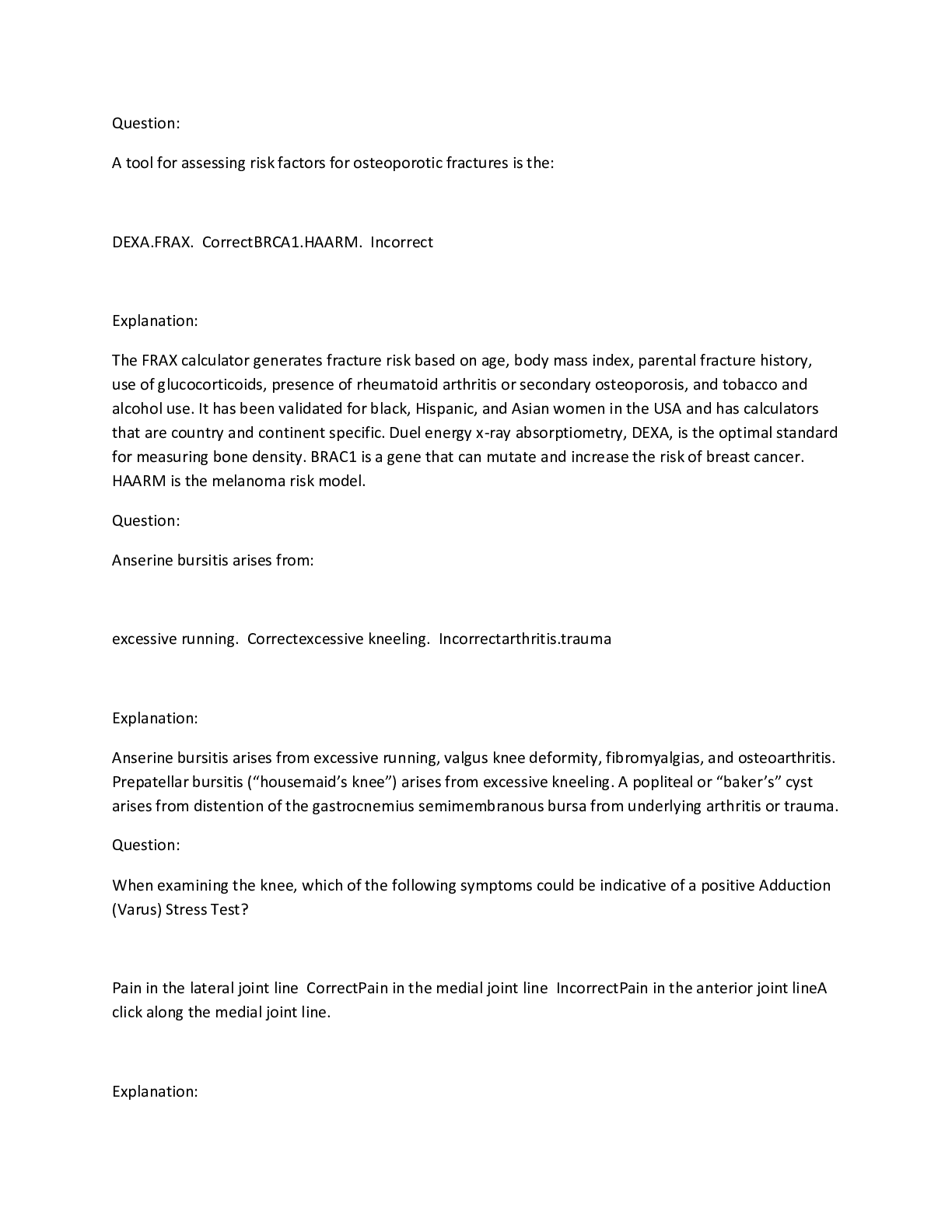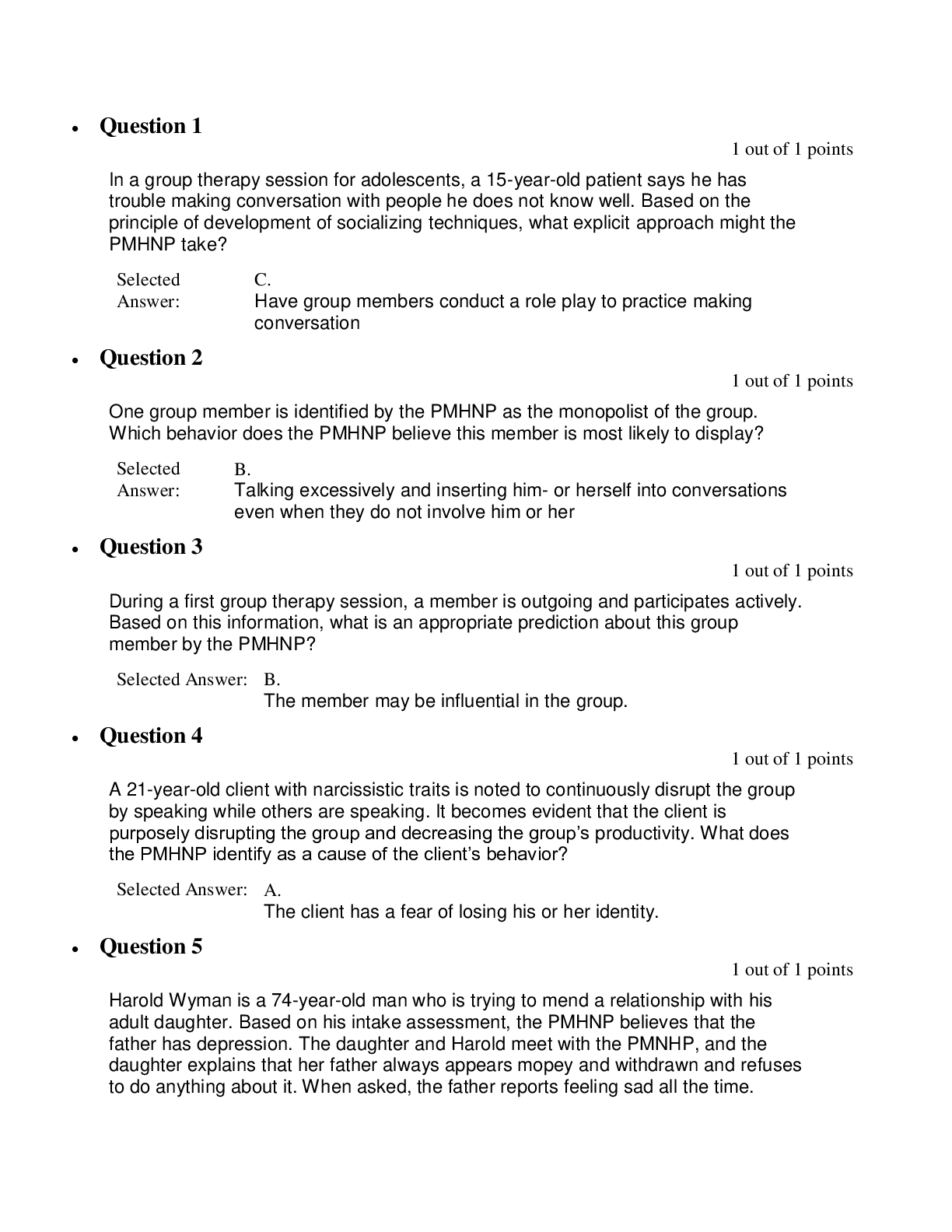NR 508 MIDTERM EXAM – QUESTION AND ANSWERS SET 3(VERIFIED ANSWERS)
Document Content and Description Below
NR 508 MIDTERM EXAM – QUESTION AND ANSWERS SET 3NR 508 MIDTERM EXAM – QUESTION AND ANSWERS SET 3 Question 1 2 / 2 pts A patient has three consecutive blood pressure readings of 140/95 mm Hg. Th... e patient’s body mass index is 24. A fasting plasma glucose is 100 mg/dL. Creatinine clearance and cholesterol tests are normal. The primary care NP should order: a β-blocker. an angiotensin-converting enzyme inhibitor. a thiazide diuretic. dietary and lifestyle changes. Question 2 2 / 2 pts An African-American patient is taking captopril (Capoten) 25 mg twice daily. When performing a physical examination, the primary care nurse practitioner (NP) learns that the patient continues to have blood pressure readings of 135/90 mm Hg. The NP should: increase the captopril dose to 50 mg twice daily. ! add a thiazide diuretic to this patient’s regimen. change the drug to losartan (Cozaar) 50 mg once daily. recommend a low-sodium diet in addition to the medication. Question 3 2 / 2 pts A 50-year-old woman reports severe, frequent hot flashes and vaginal dryness. She is having irregular periods. She has no family history of CHD or breast cancer and has no personal risk factors. The primary care NP should recommend: estrogen-only HT. ! low-dose oral contraceptive therapy. selective serotonin reuptake inhibitor therapy until menopause begins. estrogen-progesterone HT. Question 4 2 / 2 pts The primary care NP is prescribing a medication for an off-label use. To help prevent a medication error, the NP should: ! write “off-label use” on the prescription and provide a rationale. call the pharmacist to explain why the instructions deviate from common use. write the alternative drug regimen on the prescription and send it to the pharmacy. tell the patient to ignore the label directions and follow the verbal instructions given in the clinic. Question 5 2 / 2 pts The primary care nurse practitioner (NP) sees a patient in the clinic who has a blood pressure of 130/85 mm Hg. The patient’s laboratory tests reveal high-density lipoprotein, 35 mg/dL; triglycerides, 120 mg/dL; and fasting plasma glucose, 100 mg/dL. The NP calculates a body mass index of 29. The patient has a positive family history for cardiovascular disease. The NP should: prescribe a thiazide diuretic. consider treatment with an angiotensin-converting enzyme inhibitor. reassure the patient that these findings are normal. ! Counsel the patient about dietary and lifestyle changes. Question 6 2 / 2 pts A patient who has had a new onset of AF the day prior will undergo cardioversion that day. The primary care NP will expect the cardiologist to: give clopidogrel after administering cardioversion. ! Administer cardioversion without using anticoagulants. give warfarin and aspirin before attempting cardioversion. give low-dose aspirin before administering cardioversion. Question 7 2 / 2 pts A patient in the clinic reports frequent episodes of bloating, abdominal pain, and loose stools to the primary care nurse practitioner (NP). An important question the NP should ask about the abdominal pain is: ! the relation of the pain to stools. what time of day the pain occurs. whether the pain is sharp or diffuse. the age of the patient when the pain began. Question 8 2 / 2 pts A 55-year-old woman has a history of myocardial infarction (MI). A lipid profile reveals LDL of 130 mg/dL, HDL of 35 mg/dL, and triglycerides 150 mg/dL. The woman is sedentary with a body mass index of 26. The woman asks the primary care NP about using a statin medication. The NP should: Recommend dietary and lifestyle changes first. ! Begin therapy with atorvastatin 10 mg per day. Discuss quality-of-life issues as part of the decision to begin medication. Tell her there is no clinical evidence of efficacy of statin medication in her case. Question 9 2 / 2 pts A 2-year-old child has chronic “toddler’s” diarrhea, which has an unknown but benign etiology. The child’s parent asks the primary care NP if a medication can be used to treat the child’s symptoms. The NP should recommend giving: diphenoxylate (Lomotil). attapulgite (Kaopectate). ! an electrolyte solution (Pedialyte). bismuth subsalicylate (Pepto-Bismol). Question 10 2 / 2 pts A patient who has hyperlipidemia has been taking atorvastatin (Lipitor) 60 mg daily for 6 months. The patient’s initial lipid profile showed LDL of 180 mg/dL, HDL of 45 mg/dL, and triglycerides of 160 mg/dL. The primary care NP orders a lipid profile today that shows LDL of 105 mg/dL, HDL of 50 mg/dL, and triglycerides of 120 mg/dL. The patient reports muscle pain and weakness. The NP should: order liver function tests (LFTs). ! order a creatine kinase-MM (CK-MM) level. change atorvastatin to twice-daily dosing. add gemfibrozil (Lopid) to the patient’s medication regimen. Question 11 2 / 2 pts A patient brings written information about a medication to a primary care NP about a new drug called Prism and wants to know if the NP will prescribe it. The NP notes that the information is from an internet site called “Prism.com.” The NP should tell this patient that: ! this information is probably from a drug advertisement website. this is factual, evidence-based material with accurate information. the information is from a nonprofit group that will not profit from drug sales. internet information is unreliable because anyone can post information there. Question 12 2 / 2 pts A patient who is taking an ACE inhibitor sees the primary care NP for a follow-up visit. The patient reports having a persistent cough. The NP should: ! consider changing the medication to an ARB. order a bronchodilator to counter the bronchospasm caused by this drug. ask whether the patient has had any associated facial swelling with this cough. reassure the patient that tolerance to this adverse effect will develop over time. Question 13 2 / 2 pts A primary care NP is prescribing a drug for a patient who does not take any other medications. The NP should realize that: CYP450 enzyme reactions will not interfere with this drug’s metabolism. substrates such as alcohol cannot interfere with the drug when the patient is abstaining. food-drug interactions are limited to those where food enhances or inhibits drug absorption. ! a thorough history of diet, alcohol use, smoking, and over-the-counter and herbal products is required. Question 14 2 / 2 pts A male patient tells the primary care NP he is experiencing decreased libido, lack of energy, and poor concentration. The NP performs an examination and notes increased body fat and gynecomastia. A serum testosterone level is 225 ng/dL. The NP’s next action should be to: order LH and FSH levels. order a serum prolactin level. prescribe testosterone replacement. ! obtain a morning serum testosterone level. Question 15 2 / 2 pts In every state, prescriptive authority for NPs includes the ability to write prescriptions: for controlled substances. ! for specified classifications of medications. without physician-mandated involvement. with full, independent prescriptive authority. Question 16 2 / 2 pts A patient who has an upper respiratory infection reports using over-the-counter cold preparations. The primary care NP should counsel this patient to use caution when taking additional over-the-counter medications such as: ! antipyretics. calcium supplements. acid reflux medications. antioxidant supplements. Question 17 2 / 2 pts The primary care NP has referred a child who has significant gastrointestinal reflux disease to a specialist for consideration for a fundoplication and gastrostomy tube placement. The child’s weight is 80% of what is recommended for age, and a recent swallow study revealed significant risk for aspiration. The child’s parents do not want the procedure. The NP should: compromise with the parents and order a nasogastric tube for feedings. ! initiate a discussion with the parents about the potential outcomes of each possible action. refer the family to a case manager who can help guide the parents to the best decision. understand that the child’s parents have a right to make choices that override those of the medical team. Question 18 2 / 2 pts A patient who has experienced five to seven liquid stools for 3 days is seen in the clinic by the primary care NP. The patient reports having had fever, mucoid stools, and nausea without vomiting. The patient has been drinking Gatorade to stay hydrated. The NP obtains a stool specimen for culture and should prescribe: diphenoxylate (Lomotil). attapulgite (Kaopectate). ! bismuth subsalicylate (Pepto-Bismol). loperamide hydrochloride (Imodium). Question 19 2 / 2 pts A patient reports having occasional acute constipation with large, hard stools and pain and asks the primary care NP about medication to treat this condition. The NP learns that the patient drinks 1500 mL of water daily; eats fruits, vegetables, and bran; and exercises regularly. The NP should recommend: a daily bulk laxative. long-term docusate sodium. ! a saline laxative as needed. glycerin suppositories as needed. Question 20 2 / 2 pts A postpartum woman will begin taking the minipill while she is nursing her infant. The primary care NP should instruct the patient: to use backup contraception while taking the minipill. to continue using the minipill for 6 months after she stops nursing. that irregular periods while taking the minipill may indicate she is pregnant. ! that this method does not increase her risk of thromboembolic events. Question 21 2 / 2 pts A patient comes to the clinic to discuss weight loss. The primary care NP notes a BMI of 32 and performs a health risk assessment that reveals no obesity-related risk factors. The NP should recommend: orlistat (Xenical). surgical intervention. changes in diet and exercise. ! changes in diet and exercise along with short-term phentermine. Question 22 2 / 2 pts A patient who has asthma and who is known to the primary care NP calls the NP after hours and asks for a refill of an albuterol metered-dose inhaler. The patient has not been seen in the clinic for more than a year. The NP should: call the pharmacy to order the medication with several refills. send an electronic prescription to the pharmacy for one time only. send the patient to the emergency department for evaluation of symptoms. ! refill the drug and tell the patient that an office visit is necessary for further refills. Question 23 2 / 2 pts A patient reports fatigue, weight loss, and dry skin. The primary care nurse practitioner (NP) orders thyroid function tests. The patient’s thyroid stimulating hormone (TSH) is 40 microunits/mL, and T4 is 0.1 ng/mL. The NP should refer the patient to an endocrinologist and prescribe: methimazole. liothyronine. ! levothyroxine. propylthiouracil. Question 24 2 / 2 pts A patient who takes nitroglycerin for stable angina pectoris develops hypertension. The primary care NP should contact the patient’s cardiologist to discuss adding: amlodipine (Norvasc). diltiazem (Cardizem). verapamil HCl (Calan). ! nifedipine (Procardia XL). Question 25 2 / 2 pts A primary care NP will begin practicing in a state in which the governor has opted out of the federal facility reimbursement requirement. The NP should be aware that this defines how NPs may write prescriptions: without physician supervision in private practice. ! as CRNAs without physician supervision in a hospital setting. in any situation but will not be reimbursed for this by government insurers. only with physician supervision in both private practice and a hospital setting. Question 26 2 / 2 pts A patient who has stable angina and uses sublingual nitroglycerin tablets is in the clinic and begins having chest pain. The primary care NP administers a nitroglycerin tablet and instructs the patient to lie down. The NP’s next action should be to: obtain an electrocardiogram. ! administer oxygen at 2 L/minute. give 325 mg of chewable aspirin. call EMS. Question 27 2 / 2 pts The primary care NP sees a new African-American patient who has blood pressure readings of 140/90 mm Hg, 130/85 mm Hg, and 142/80 mm Hg on three separate occasions. The NP learns that the patient has a family history of hypertension. The NP should: ! initiate monotherapy with a thiazide diuretic. prescribe a thiazide diuretic and an angiotensin-converting enzyme inhibitor. discuss dietary and lifestyle modifications with the patient. begin combination therapy with an ARB and a calcium-channel blocker. Question 28 2 / 2 pts A patient who has diabetes is taking simvastatin (Zocor) 80 mg daily to treat LDL cholesterol level of 170 mg/dL. The patient has a body mass index of 29. At a follow-up visit, the patient’s LDL level is 120 mg/dL. The primary care NP should consider: increasing the simvastatin to 80 mg twice daily. adding nicotinic acid to the patient’s drug regimen. ! changing the medication to ezetimibe/simvastatin (Vytorin). referring the patient to a dietitian for assistance with weight reduction. Question 29 2 / 2 pts The primary care nurse practitioner (NP) writes a prescription for an antibiotic using an electronic drug prescription system. The pharmacist will fill this prescription when: ! the electronic prescription is received. the patient brings a written copy of the prescription. a copy of the written prescription is faxed to the pharmacy. the pharmacist accesses the patient’s electronic record to verify. Question 30 2 / 2 pts A patient with a previous history of myocardial infarction (MI) who takes nitroglycerin for angina develops hypertension. The primary care NP is considering ordering an ACE inhibitor. Preliminary laboratory tests reveal decreased renal function. The NP should: begin therapy with a low-dose ACE inhibitor. choose an ARB instead. add a low-dose thiazide diuretic to the drug regimen. ! order a renal perfusion study before starting treatment. . Question 31 2 / 2 pts A woman who is taking a progestin-only pill has just stopped nursing her 9-month-old infant and tells the primary care NP that she would like to space her children about 2 years apart. The NP should: discontinue the progestin-only pill. ! prescribe a COCP and a folic acid supplement. prescribe a progestin-only pill for another 6 months. suggest that she use a barrier method of contraception. Question 32 2 / 2 pts A primary care NP is aware that many patients in the community use herbal remedies to treat various conditions. The NP understands the importance of: ! learning about the actions, uses, doses, and toxicities of these agents. prescribing these agents when possible to ensure safe dosing. counseling patients to stop using herbal products to avoid toxic side effects. teaching patients that these products are unregulated and unsafe to use. Question 33 2 / 2 pts A patient who has a history of chronic constipation uses a bulk laxative to prevent episodes of acute constipation. The patient reports having an increased frequency of episodes. The primary care NP should recommend: ! adding docusate sodium (Colace). polyethylene glycol (MiraLAX) and bisacodyl (Dulcolax). lactulose (Chronulac) and polyethylene glycol (MiraLAX). adding nonpharmacologic measures such as biofeedback. Question 34 2 / 2 pts A 5-year-old child has chronic constipation. The primary care NP plans to prescribe a laxative for long-term management. In addition to pharmacologic therapy, the NP should also recommend _____ g of fiber per day. ! 10 15 20 25 Question 35 2 / 2 pts A patient who has breast cancer has been taking toremifene for 2 weeks. She tells her primary care NP that she thinks her tumor has grown larger. The NP should: schedule her for a breast ultrasound. ! reassure her that this is common and will subside. tell her she may need an increased dose of this medication. contact her oncologist to discuss adding another medication. Question 36 0 / 2 pts A patient is given a diagnosis of peptic ulcer disease. A laboratory test confirms the presence of Helicobacter pylori. The primary care NP orders a proton pump inhibitor (PPI) before meals twice daily, clarithromycin, and amoxicillin. After 14 days of treatment, H. pylori is still present. The NP should order: continuation of the PPI for 4 to 8 weeks. Answer a PPI, amoxicillin, and metronidazole for 14 days. a PPI, clarithromycin, and amoxicillin for 14 more days. You Answered a PPI, bismuth subsalicylate, tetracycline, and metronidazole. Question 37 2 / 2 pts A patient who has angina uses 0.4 mg of sublingual nitroglycerin for angina episodes. The patient brings a log of angina episodes to an annual physical examination. The primary care NP notes that the patient has experienced an increase in frequency of episodes in the past month but no increase in duration or severity of pain. The NP should: increase the nitroglycerin dose to 0.6 mg per dose. change from a sublingual to a transdermal patch nitroglycerin. discontinue the nitroglycerin and order ranolazine (Ranexa ER). ! contact the patient’s cardiologist to discuss admission to the hospital. . Question 38 2 / 2 pts A patient comes to the clinic reporting dizziness and fatigue associated with nausea and vomiting. The primary care NP suspects anemia and orders a complete blood count. The patient’s hemoglobin is elevated. The NP ly concludes that the patient is not anemic. The NP has made an error in: context formulation. inappropriate knowledge base. cost-versus-benefit analysis. ! hypothesis triggering and information processing. Question 39 2 / 2 pts A patient with type 2 diabetes mellitus takes metformin (Glucophage) 1000 mg twice daily and glyburide (Micronase) 12 mg daily. At an annual physical examination, the BMI is 29 and hemoglobin A1c is 7.3%. The NP should: ! begin insulin therapy. change to therapy with colesevelam (Welchol). add a third oral antidiabetic agent to this patient’s drug regimen. enroll the patient in a weight loss program to achieve better glycemic control. Question 40 2 / 2 pts A patient who has a history of angina has sublingual nitroglycerin tablets to use as needed. The primary care nurse practitioner (NP) reviews this medication with the patient at the patient’s annual physical examination. Which statement by the patient indicates understanding of the medication? ! “I should call 9-1-1 if chest pain persists 5 minutes after the first dose.” “I should take 3 nitroglycerin tablets 5 minutes apart and then call 9-1-1.” “I should take aspirin along with the nitroglycerin when I have chest pain.” “I should take nitroglycerin and then rest for 15 minutes before taking the next dose.” Question 41 2 / 2 pts The primary care nurse practitioner (NP) sees a patient for a physical examination and orders laboratory tests that reveal low-density lipoprotein (LDL) of 100 mg/dL, high-density lipoprotein (HDL) of 30 mg/dL, and triglycerides of 350 mg/dL. The patient has no previous history of coronary heart disease. The NP should consider prescribing: ezetimibe (Zetia). ! gemfibrozil (Lopid). simvastatin (Zocor). nicotinic acid (Niaspan). Question 42 2 / 2 pts A primary care NP sees a 5-year-old child who is morbidly obese. The child has an elevated hemoglobin A1c and increased lipid levels. Both of the child’s parents are overweight but not obese, and they tell the NP that they see nothing wrong with their child. They both state that it is difficult to refuse their child’s requests for soda or ice cream. The NP should: suggest that they give the child diet soda and low-fat frozen yogurt. understand and respect the parents’ beliefs about their child’s self-image. ! initiate a dialogue with the parents about the implications of the child’s laboratory values. suggest family counseling to explore ways to improve parenting skills and limits. Question 43 2 / 2 pts The primary care NP sees a new patient who has diabetes and hypertension and has been taking a thiazide diuretic for 6 months. The patient’s blood pressure at the beginning of treatment was 150/95 mm Hg. The blood pressure today is 138/85 mm Hg. The NP should: order a β-blocker. ! add an angiotensin-converting enzyme inhibitor. continue the current drug regimen. change to an aldosterone antagonist medication. Question 44 2 / 2 pts The primary care NP is considering prescribing captopril (Capoten) for a patient. The NP learns that the patient has decreased renal function and has renal artery stenosis in the right kidney. The NP should: ! initiate ACE inhibitor therapy at a low dose. consider a different drug class to treat this patient’s symptoms. give the captopril with a thiazide diuretic to improve renal function. order lisinopril (Zestril) instead of captopril to avoid increased nephropathy. Question 45 2 / 2 pts A 40-year-old patient is in the clinic for a routine physical examination. The patient has a body mass index (BMI) of 26. The patient is active and walks a dog daily. A lipid profile reveals low-density lipoprotein (LDL) of 100 mg/dL, high-density lipoprotein (HDL) of 30 mg/dL, and triglycerides of 250 mg/dL. The primary care nurse practitioner (NP) should: ! order a fasting plasma glucose level. consider prescribing metformin (Glucophage). suggest dietary changes and increased exercise. obtain serum insulin and hemoglobin A1c levels. Question 46 2 / 2 pts An African-American patient who is obese has persistent blood pressure readings greater than 150/95 mm Hg despite treatment with a thiazide diuretic. The primary care NP should consider prescribing a(n): angiotensin receptor blocker. β-blocker. ACE inhibitor. ! calcium channel blocker. Question 47 2 / 2 pts A primary care NP sees a 3-year-old patient who has been vomiting for several days. The child has had fewer episodes of vomiting the past day and is now able to take sips of fluids without vomiting. The child has dry oral mucous membranes, 2-second capillary refill, and pale but warm skin. The child’s blood pressure is 88/46 mm Hg, the heart rate is 110 beats per minute, and the temperature is 37.2° C. The NP should: prescribe promethazine. prescribe a scopolamine patch. ! begin oral rehydration therapy. send the child to the hospital for IV fluids. Question 48 2 / 2 pts A woman comes to the clinic to talk about weight reduction. The primary care nurse practitioner (NP) calculates a body mass index (BMI) of 28. The woman’s waist measures 34 inches. The woman tells the NP that she would like to lose 20 lb for her daughter’s wedding in 6 months. The NP should: suggest she try over-the-counter (OTC) orlistat. consider prescribing phentermine short-term. ! discuss her short-term and long-term weight loss goals. give her information about physical activity and diet modification. . Question 49 2 / 2 pts A patient who has diabetes is taking metformin 1000 mg daily. At a clinic visit, the patient reports having abdominal pain and nausea. The primary care NP notes a heart rate of 92 beats per minute. The NP should: obtain LFTs. decrease the dose of metformin. change metformin to glyburide. ! order electrolytes, ketones, and serum glucose. . Question 50 2 / 2 pts A patient reports having episodes of dizziness, nausea, and lightheadedness and describes a sensation of the room spinning when these occur. The primary care NP will refer the patient to a specialist who, after diagnostic testing, is likely to prescribe: ! meclizine. ondansetron. scopolamine. dimenhydrinate. Question 51 2 / 2 pts Which of the following has influenced an emphasis on primary care education in medical schools? ! Changes in Medicare reimbursement methods recommended in 1992 Competition from nonphysicians desiring to meet primary care shortages The need for monopolistic control in the marketplace of primary outpatient care The recognition that nonphysicians have variable success providing primary care Question 52 2 / 2 pts A patient who has GERD with erosive esophagitis has been taking a PPI for 4 weeks and reports a decrease in symptoms. The patient asks the primary care NP if the medication may be discontinued. The NP should tell the patient that: ! the dose may be decreased for long-term therapy. antireflux surgery must be done before the PPI can be discontinued. the condition may eventually be cured, but therapy must continue for years. once the symptoms have cleared completely, the medication may be discontinued. Question 53 2 / 2 pts A patient comes to the clinic with a 2-day history of cough and wheezing. The patient has no previous history of asthma. The patient reports having heartburn for several months, which has worsened considerably. The primary care NP makes a diagnosis of asthma and orders oral steroids and inhaled albuterol. The patient’s condition worsens, and a chest radiograph obtained 2 days later shows bilateral infiltrates. The NP has failed to: ! confirm the diagnosis. determine the aggressiveness of therapy. prescribe an adequate dose of medications. allow the drugs an adequate amount of time to work. Question 54 2 / 2 pts A patient who has been taking propranolol for 6 months reports having nocturnal cough and shortness of breath. The primary care NP should: tell the patient to stop taking the medication. obtain serum drug levels to monitor for toxicity of this medication. instruct the patient to increase activity and exercise to counter these side effects. ! contact the patient’s cardiologist to discuss changing to a selective β-blocker. Question 55 2 / 2 pts A primary care nurse practitioner (NP) prescribes a drug to an 80-year-old African-American woman. When selecting a drug and determining the dose, the NP should understand that the knowledge of how age, race, and gender may affect drug excretion is based on an understanding of: bioavailability. ! pharmacokinetics. pharmacodynamics. anatomy and physiology. Question 56 2 / 2 pts A patient takes a cardiac medication that has a very narrow therapeutic range. The primary care NP learns that the particular brand the patient is taking is no longer covered by the patient’s medical plan. The NP knows that the bioavailability of the drug varies from brand to brand. The NP should: ! contact the insurance provider to explain why this particular formulation is necessary. change the patient’s medication to a different drug class that doesn’t have these bioavailability variations. accept the situation and monitor the patient closely for drug effects with each prescription refill. ask the pharmaceutical company that makes the drug for samples so that the patient does not incur out-of-pocket expense. Question 57 2 / 2 pts A primary care nurse practitioner (NP) sees a patient who is concerned about constipation. The NP learns that the patient has three to four bowel movements per week with occasional hard stools but no straining with defecation. The NP should recommend: ! increased intake of fluids and fiber. docusate sodium (Colace) as needed. psyllium (Metamucil) on a daily basis. polyethylene glycol (MiraLAX) as needed. Question 58 2 / 2 pts A postmenopausal woman develops NSAID-induced ulcer. The primary care NP should prescribe: ! ranitidine (Zantac). omeprazole (Prilosec). esomeprazole (Nexium). pantoprazole (Protonix). Question 59 2 / 2 pts A patient comes to the clinic with a history of syncope and weakness for 2 to 3 days. The primary care NP notes thready, rapid pulses and 3-second capillary refill. An ECG reveals a heart rate of 198 beats per minute with a regular rhythm. The NP should: administer intravenous fluids and obtain serum electrolytes. administer amiodarone in the clinic and observe closely for response. order digoxin and verapamil and ask the patient to return for a follow-up examination in 1 week. ! send the patient to an emergency department for evaluation and treatment. Question 60 2 / 2 pts A primary care NP sees a patient who is about to take a cruise and reports having had motion sickness with nausea on a previous cruise. The NP prescribes the scopolamine transdermal patch and should instruct the patient to apply the patch: daily. ! every 3 days. as needed for nausea. 1 hour before embarking. [Show More]
Last updated: 2 years ago
Preview 1 out of 39 pages

Buy this document to get the full access instantly
Instant Download Access after purchase
Buy NowInstant download
We Accept:

Reviews( 0 )
$11.00
Can't find what you want? Try our AI powered Search
Document information
Connected school, study & course
About the document
Uploaded On
Jan 23, 2021
Number of pages
39
Written in
Additional information
This document has been written for:
Uploaded
Jan 23, 2021
Downloads
0
Views
73


